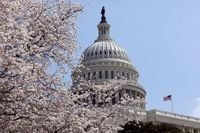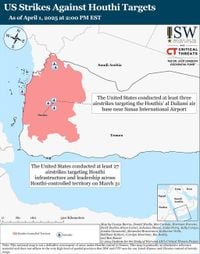In a dramatic escalation of tensions, experts warn that an Iranian attack on British military facilities in the Chagos Islands could trigger a larger regional conflict. Iranian forces have recently called for a pre-emptive strike on the Diego Garcia UK-US Pacific security outpost, a strategic military base that has long been a focal point of Western military operations in the Indian Ocean. This alarming development comes in the wake of the arrival of at least three US B-2 Spirit Stealth Bombers at Diego Garcia, which have been interpreted by Iranian officials as a direct threat to their national security.
According to security analysts, the Iranian military has been ordered to prepare for a strike on Diego Garcia to deter any potential American attack on Iran's mainland. The presence of the B-2 bombers, known for their capability to carry out long-range bombing missions, has heightened fears in Tehran. Satellite images revealing the bombers parked on the airstrip have further fueled speculation about US intentions. Former UK military intelligence commander Philip Ingram noted, "Iran has the capability on paper to strike Diego Garcia. They know the US would respond by destroying the Islamic Revolutionary Guard Corps across Iran." Ingram believes that Iran's threats are largely rhetorical, intended to project strength to regional allies rather than a prelude to actual military action.
The geopolitical backdrop to this situation is complex. The UK has maintained a military presence on the Chagos Islands since World War II, and the future of the Diego Garcia airstrip is currently under negotiation. Mauritius, which claims sovereignty over the islands, is seeking to reclaim control, and the UK has proposed a 99-year lease for military operations. However, new Mauritian Prime Minister Navin Ramgoolam has expressed a desire to renegotiate the terms, demanding a significant increase in lease payments.
In a related development, US President Donald Trump has issued stark warnings to Iran, threatening "bombing, the likes of which we have never seen before" if the country fails to strike a deal regarding its nuclear program. Trump's comments have drawn sharp rebukes from Iranian officials, including a complaint to the United Nations Security Council regarding his "reckless and belligerent" remarks. Iranian Supreme Leader Ayatollah Ali Khamenei responded to these threats by stating, "If they commit any mischief, they will surely receive a strong reciprocal blow." This statement underscores the high stakes involved, as Iran possesses a significant arsenal of ballistic missiles and drones capable of reaching the Chagos Islands.
As tensions mount, the implications for regional stability are profound. An attack on Diego Garcia could lead to a broader conflict, with Israel likely joining the US in retaliatory strikes against Iranian military facilities. The Iranian military has previously demonstrated its missile capabilities, and any confrontation could escalate quickly.
Meanwhile, Republican lawmakers in the United States are pushing for a tougher stance against Tehran, advocating for new legislation aimed at increasing pressure on the Islamic Republic. The Republican Study Committee recently outlined ten proposed acts, including measures to curb Iranian influence in Iraq and impose sanctions on corrupt Iranian officials. Congressman August Pfluger emphasized that the Iranian people are not the target of these measures, but rather the leadership that seeks to develop nuclear weapons.
Despite the escalating rhetoric, the US intelligence community assesses that Iran is not actively building nuclear weapons at this time. However, the taboo surrounding discussions of nuclear capabilities in Iran appears to be eroding, raising concerns among US officials. Representative Zach Nunn stated that Tehran has a clear opportunity to enter negotiations in good faith, while Trump’s administration continues to advocate for a complete dismantlement of Iran's nuclear program.
The situation is further complicated by the refusal of Gulf states, including Saudi Arabia, the UAE, and Qatar, to allow US warplanes to use their airspace for attacks against Iran. This ban represents a significant setback for the Trump administration, which had hoped to leverage support from its Arab allies to exert pressure on Tehran. The absence of Gulf cooperation could embolden Iran's negotiating position, as they recognize that the US's regional partners are unwilling to participate in military action.
In response to the Gulf states' refusal, the US has shifted its focus to the Diego Garcia base, amassing B-2 bombers there to ensure a strategic position for potential operations against Iran. This base, located approximately 5,300 kilometers from Iran, is well within the operational range of the B-2 bombers, capable of carrying out precision strikes on Iranian targets.
As the situation continues to evolve, experts are closely monitoring the potential for conflict. The US military's recent deployment of long-range bombers to Diego Garcia has drawn parallels to past military interventions in the region, raising questions about the administration's intentions. With the stakes higher than ever, the world watches as diplomatic efforts to resolve the crisis remain tenuous at best.
In summary, the potential for an Iranian attack on Diego Garcia presents a serious threat to regional stability, with far-reaching consequences for international relations. As both sides engage in a dangerous game of brinkmanship, the hope for a peaceful resolution hangs in the balance.








